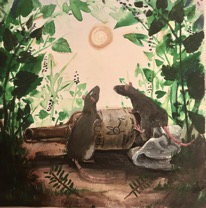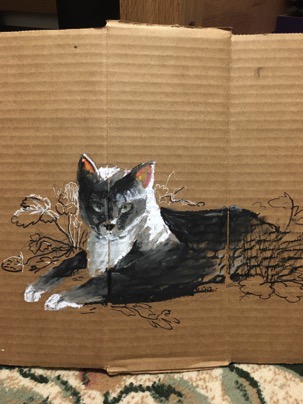2019
Recognizing Pain in Animals
10/30/2019
“Animals hide pain as a defense mechanism to protect them in the wild.” I have heard this often over the years, from veterinarians and those who love animals. There may be some truth to this statement, we really can’t fully know why animals do what they do, but that doesn’t mean we can’t try to understand them better. It can be challenging to recognize signs of pain and discomfort in our animals, but they are often not intentionally hiding their pain in the comfort of their domestic home environment. A perfect example is the dog that lifts her paw to have her person remove a thorn. We as humans can improve our caregiving abilities by learning the physical and behavioral signs that they display when they are hurting. And honestly, putting ourselves “in their paws” can be a useful technique. Their nervous systems function very much like ours. They feel acute pain and adapt to ongoing pain much as we do. I often ask people who experience chronic pain to consider how many people around them are actually aware of their level of pain — we humans hide our pain as well!
Did you know that animals often make grimacing facial expressions when they are feeling pain? Covered with fur, their faces can be harder to read, but scientists have recognized specific facial features such as squinting eyes, flattened ear position, a “nose bump” where the bridge of the nose would be on a person, and muzzle bulges on their “cheeks” making the whiskers point out further to the sides. These signs can sometimes be seen with anxiety as well, so it is important to take them in context and to watch for them over time. Chronic pain is common in animals just as it is in humans, due to osteoarthritis, some cancers, infections, and injuries.
Click here for more signs of pain in animals.
Pain management involves a multimodal approach using weight control, exercise and movement, herbal and nutritional supplements, multiple types of physical therapy, and pharmaceutical drugs. As an integrative veterinarian with herbal medicine in my toolkit, I have been very pleased with the improvements in my patients with just a few simple additions to their care. Contact me for a holistic assessment and see if an individualized herbal pain support formula can help the animals in your life to be more happy, energetic and comfortable.
Did you know that animals often make grimacing facial expressions when they are feeling pain? Covered with fur, their faces can be harder to read, but scientists have recognized specific facial features such as squinting eyes, flattened ear position, a “nose bump” where the bridge of the nose would be on a person, and muzzle bulges on their “cheeks” making the whiskers point out further to the sides. These signs can sometimes be seen with anxiety as well, so it is important to take them in context and to watch for them over time. Chronic pain is common in animals just as it is in humans, due to osteoarthritis, some cancers, infections, and injuries.
Click here for more signs of pain in animals.
Pain management involves a multimodal approach using weight control, exercise and movement, herbal and nutritional supplements, multiple types of physical therapy, and pharmaceutical drugs. As an integrative veterinarian with herbal medicine in my toolkit, I have been very pleased with the improvements in my patients with just a few simple additions to their care. Contact me for a holistic assessment and see if an individualized herbal pain support formula can help the animals in your life to be more happy, energetic and comfortable.
Kate's Memorial Artwork!
05/13/2019

I have a young friend (an Ecology and Studio Art major at UNI) who is an amazing artist and has put her skills to work creating lovely memorial artwork of animals incorporating personal aspects of their lives in beautiful and whimsical ways.
The paintings above are of her family's cat, Cinder, and their adorable pet rats. This family had many losses all in a very short time and pulling them all together into this beautiful world has helped them to remember and enjoy the wonderful times with all of these loved ones. Going through the process of deciding what to include has been healing in its own way.
"These are an homage to the lives of our dear friends, so to fully capture their personalities, the tales of their daring exploits must also be included. The plants, objects, and animals all represent a story so they will always be remembered." -Kate
Kate is also quite talented a capturing the living - see Berlioz below "He’s a cute li’l guy isn’t he?" She works in various types of media including recycled materials!
If you are interested in talking to her about commissioning a personal piece of art, let me know and I can put you in touch!

Dangers of Grain Free Diets?!
04/09/2019
Grain free diets for animals have been popular for many years now due to various concerns about food allergies and the human concerns with eating gluten-free. Unfortunately, a trend is being seen of some dogs (and a few cats) developing a heart condition called DCM (Dilated Cardiomyopathy) that may be connected to diet. This condition has previously only been seen in specific breeds with a genetic predisposition (Boxers, Great Danes, Doberman pincers,…) Now it is being seen in other breeds of dogs and a connecting factor is the feeding of "Boutique, Exotic ingredient, and Grain-Free" diets (labeled BEG diets by researchers). So far, concerns for large amounts of chickpeas, peas, lentils and other legumes, and potatoes (sweet and regular) as substitutes for protein and carbohydrate needs has been singled out, though there are still a lot of unknowns including genetic differences in metabolism. A similar condition
occurred in cats many years ago and was linked to taurine insufficiency in diets. Now all cat foods are supplemented with taurine. This appears to be related, but a simple taurine addition has not been sufficient in the case of these dogs.
Switching to a more research-based brand has reversed the condition in several cases. The official recommendation is to stick with the "Big 5" dog food brands that have more extensive research and feeding trials: Eukanuba, Iams, Hill's Science Diet, Purina (ProPlan & higher end versions), and Royal Canin. Studies are continuing in order to learn more about what may be affecting these dogs. Sadly, signs of DCM heart disease come on suddenly and some have died. Though still very rare, over 300 animals (6 cats, the rest dogs) in the last 5 years have been diagnosed as having DCM with what seems to be a dietary connection. For all we know about nutrition, there is still so much unknown. Dietary rotation (feeding a few different brands and ingredients) is an option to avoid long term effects of nutritional deficiencies with any one diet as well as ingredient concerns such as the recent Science Diet recalls for excessive vitamin D levels. Home cooked diets are another option, but this can also have concerns of nutritional deficiencies. Varying ingredients and sticking with recipes formulated by boarded veterinary nutritionists are important steps. Please avoid random online sites for homemade diets! I can help to guide these choices. If you would like to schedule an examination and to discuss your animal's dietary needs, please contact me!
For more nutrition discussion see topics in Pet Care: Healthy Diet and Supplements
Here is a link to a good explanation from NC State Veterinary Hospital
© 2010
occurred in cats many years ago and was linked to taurine insufficiency in diets. Now all cat foods are supplemented with taurine. This appears to be related, but a simple taurine addition has not been sufficient in the case of these dogs.
Switching to a more research-based brand has reversed the condition in several cases. The official recommendation is to stick with the "Big 5" dog food brands that have more extensive research and feeding trials: Eukanuba, Iams, Hill's Science Diet, Purina (ProPlan & higher end versions), and Royal Canin. Studies are continuing in order to learn more about what may be affecting these dogs. Sadly, signs of DCM heart disease come on suddenly and some have died. Though still very rare, over 300 animals (6 cats, the rest dogs) in the last 5 years have been diagnosed as having DCM with what seems to be a dietary connection. For all we know about nutrition, there is still so much unknown. Dietary rotation (feeding a few different brands and ingredients) is an option to avoid long term effects of nutritional deficiencies with any one diet as well as ingredient concerns such as the recent Science Diet recalls for excessive vitamin D levels. Home cooked diets are another option, but this can also have concerns of nutritional deficiencies. Varying ingredients and sticking with recipes formulated by boarded veterinary nutritionists are important steps. Please avoid random online sites for homemade diets! I can help to guide these choices. If you would like to schedule an examination and to discuss your animal's dietary needs, please contact me!
For more nutrition discussion see topics in Pet Care: Healthy Diet and Supplements
Here is a link to a good explanation from NC State Veterinary Hospital
© 2010
